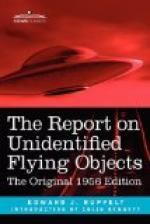All of these inquiries from the press were adding to Blue Book’s work load and to my problems. Normally a military unit such as ATIC has its own public information officer, but we had none so I was it. I was being quoted quite freely in the press and was repeatedly being snarled at by someone in the Pentagon. It was almost a daily occurrence to have people from the “puzzle palace” call and indignantly ask, “Why did you tell them that?” They usually referred to some bit of information that somebody didn’t think should have been released. I finally gave up and complained to Colonel Dunn. I suggested that any contacts with the press be made through the Office of Public Information in the Pentagon. These people were trained and paid to do this job; I wasn’t. Colonel Dunn heartily agreed because every time I got chewed out he at least got a dirty look.
Colonel Dunn called General Samford’s office and they brought in General Sory Smith of the Department of Defense, Office of Public Information. General Smith appointed a civilian on the Air Force Press Desk, Al Chop, to handle all inquiries from the press. The plan was that Al would try to get his answers from Major Dewey Fournet, Blue Book’s liaison officer in the Pentagon, and if Dewey didn’t have the answer, Al had permission to call me.
This arrangement worked out fine because Al Chop had been through previous UFO publicity battles when he was in the Office of Public Information at Wright Field.
The interest in the UFO’s that was shown by the press in May was surpassed only by the interest of the Pentagon. Starting in May, I gave on the average of one briefing in Washington every two weeks, and there was always a full house. From the tone of the official comments to the public about UFO’s, it would indicate that there wasn’t a great deal of interest, but nothing could be further from the truth. People say a lot of things behind a door bearing a sign that reads “Secret Briefing in Progress.”
After one of the briefings a colonel (who is now a brigadier general) presented a plan that called for using several flights of F-94C jet interceptors for the specific purpose of trying to get some good photographs of UFO’s. The flight that he proposed would be an operational unit with six aircraft—two would be on constant alert. The F-94C’s, then the hottest operational jet we had, would be stripped of all combat gear to give them peak performance, and they would carry a special camera in the nose. The squadrons would be located at places in the United States where UFO’s were most frequently seen.
The plan progressed to the point of estimating how soon enough airplanes for two flights could be stripped, how soon special cameras could be built, and whether or not two specific Air Force bases in the U.S. could support the units.
Finally the colonel’s plan was shelved, but not because he was considered to be crazy. After considerable study and debate at high command level, it was decided that twelve F-94C’s couldn’t be spared for the job and it would have been ineffective to use fewer airplanes.




